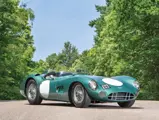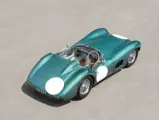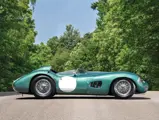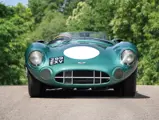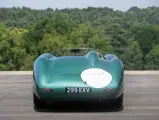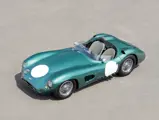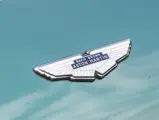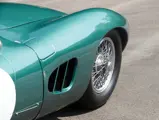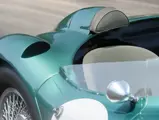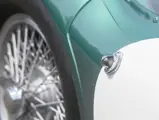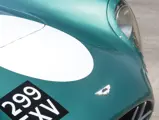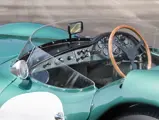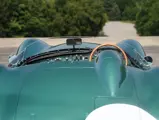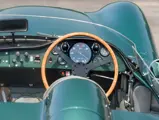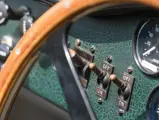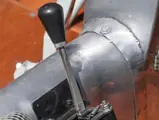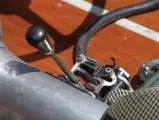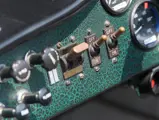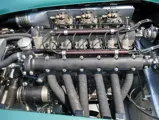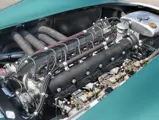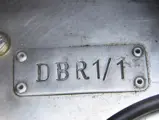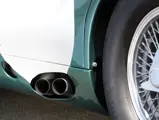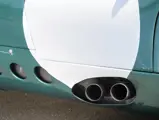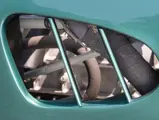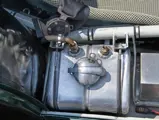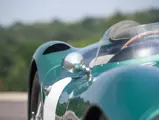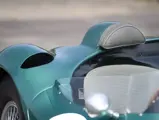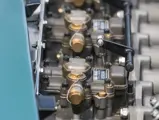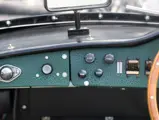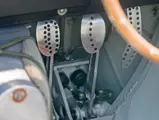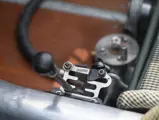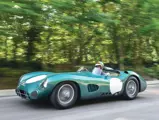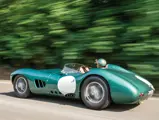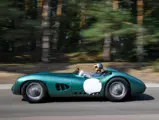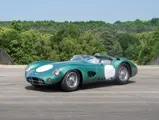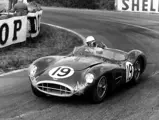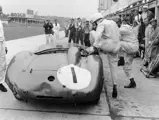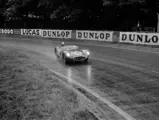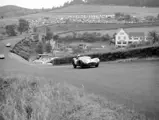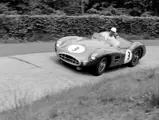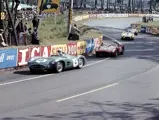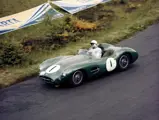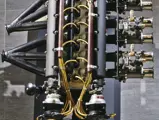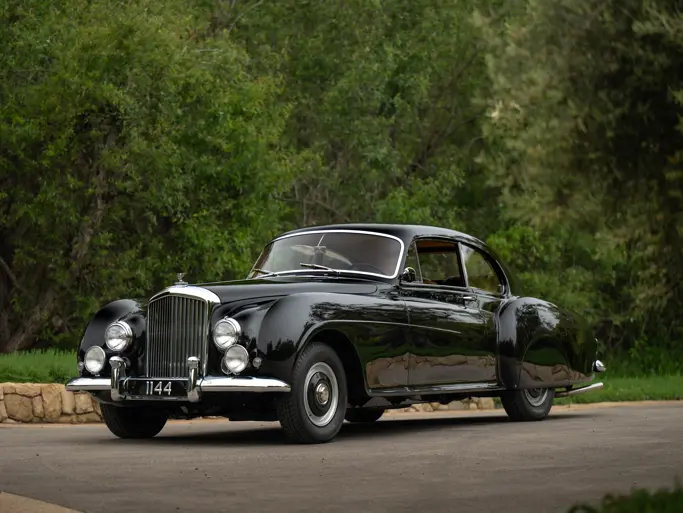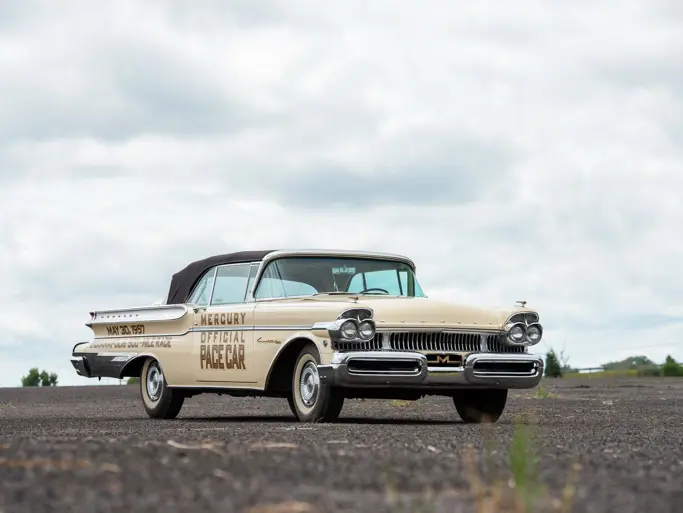Monterey 2017
1956 Aston Martin DBR1
Aston Martin Motorsport
{{lr.item.text}}
$22,550,000 USD | Sold
 | Monterey, California
| Monterey, California
{{internetCurrentBid}}
{{internetTimeLeft}}

- The first of five DBR1s
- Winner of the 1959 Nürburgring 1000 KM; sister to the 1959 Le Mans winner
- Raced by Roy Salvadori, Stirling Moss, Jack Brabham, and Carroll Shelby, among others
- Fitted with correct reproduction engine for racing, offered with the original
- Maintained by Aston Martin specialists R.S. Williams
- The most important model in Aston Martin history
Accelerating hard in third gear to 6,700 rpm, the DBR1 closes fast on the tight but sweeping right-hander ahead. Faithfully following the undulating asphalt cutting through the mountainside, the Aston chases by the straight-six’s raucous notes ricocheting off the craggy rock face, grip from the hot Dunlop racers is tenacious, wrote leading Aston Martin author and historian Paul Chudecki in 2014.
Down into second for the cambered left/right that follows, rapidly climbing the sinuous roads from Saanen into the Swiss Alps, the twitching tail requires a touch of opposite lock before we’re hard on the throttle for the next short straight. Marvelling at its sublime handling and sheer pace, I can’t help but ponder the outcome had Aston’s most successful racer entered the Mille Miglia with its not dissimilar roads; Stirling Moss had been over one minute faster in the DBR1 over a lap of the 1958 Targa Florio than he had been in the Mercedes-Benz 300 SLR three years earlier, when the combination famously won the Mille Miglia at record speed . . .
The DBR1, of course, was the ultimate result of David Brown’s dream in 1949 to win Le Mans, one finally culminating a decade later in that elusive Sarthe victory. Following its DB2 competition entries Aston had produced the DB3, its first purpose-built sports-racing car, with the LB6 engine’s 2,580 cc latterly increased to 2,922 cc, but success was limited. Though the DB3S, its successor, was highly competitive, its improved VB6 engine’s capacity limit remained 3.0 liters and by 1955 240 bhp represented maximum development. Against much more powerful, 3.5–4.5 liter, Ferraris, Jaguars, and Maseratis, its comparative power deficit was a perpetual problem, and the exceptional performances with this engine show just how effective were Aston’s chassis. To address the deficit a new Lagonda – essentially an enlarged DB3S – appeared for 1954 with an Eberhorst-designed 4.5-liter V-12; alas the crankcase design was ultimately too weak and it was abandoned, its considerable potential un-realized, after the fast but fragile two versions failed to finish Le Mans in either 1954 or 1955.
Immediately after the latter, work began on an all-new lighter, faster, though still 3.0-liter, Aston under new race car design chief Ted Cutting. Using a perimeter-type, small-tube spaceframe chassis, the DBR1’s front transverse torsion bar suspension remained much as for the DB3/DB3S but the rear was all-new, with longitudinal (against transverse) torsion bars, trailing links, and Watt linkage rather than central-slide-located de Dion axle. Notably, the S430 four-speed box was replaced by a CG537, a semi-dry sump, five-speed transaxle, and cast-iron rather than forged-steel Girlings had light alloy calipers (a first in racing). Cutting also designed the sensuous body – for 1956 with slightly more bulbous wing contours and second-generation DB3S-style radiator intake, unlike the more flowing lines of all 1957 onwards DBR1s – formed in ultra-light 20/22 gauge alloy.
Derived from the VB6 but with little or no common components, the DBR1’s RB6, 2,922-cc engine’s bottom end was substantially redesigned – initially with four main bearings – including a lighter alloy crankcase to cope with the planned power increase; the camshaft drive also changed, from chain to gear-driven. Originally, the 60-degree, twin-plug DB3S head was used which, with triple 45DCO carburetors, increased power over the VB6 to 252 bhp at 6,000 rpm; by 1958 all RB6s had 95-degree heads, with larger valves and triple 45DCOs/50DCOs, increasing power to 242 bhp/255 bhp at 6,000 rpm.
Thus equipped the DBR1 boasted a roadholding-enhancing four-inch lower center of gravity than the DB3S. An Achilles heel would soon appear, however, the transaxle proving particularly troublesome. For 1956, under Le Mans sports prototype regulations stipulating a maximum 2.5-liter capacity and 28-gallon fuel tank, it was mated to a 2,493-cc RB6 engine (RDP5053/1) with 212 bhp at 7,000 rpm – an output influenced by having to average 10.8 mpg. On its 24 Hours debut, DBR1/1 ran well for 20 hours until running its bearings; 2nd place at both the British Empire Trophy and Easter Goodwood meetings followed early in 1957.
In May that year, back to 3.0 liters, it was joined by DBR1/2 at Spa, the Aston’s potential amply demonstrated by Tony Brooks’ easy win in DBR1/2 with Roy Salvadori 2nd in DBR1/1. Soon after, Brooks/Noel Cunningham-Reid led the Nürburgring 1000 KM from flag to finish in DBR1/2 with Salvadori/Les Leston in DBR1/1 6th; hopes were thus high for Le Mans but Brooks, running 2nd with Cunningham-Reid in DBR1/2, crashed trying to engage gear and Salvadori/Leston retired DBR1/1 with a fractured oil pipe. Then Salvadori finished 2nd in the British GP support race and Brooks won again in DBR1/2 at the Belgian GP, that year for sports cars, with Salvadori in DBR1/1 4th.
Given 3.0 liters was the engine’s maximum capacity, it was manna from heaven when 1958 regulations decreed a 3,000-cc limit. For Sebring’s 12 Hours, though, the gearbox gremlins struck again, DBR1/2 retiring after Moss had set a new lap record; Salvadori/Carroll Shelby in DBR1/1 went out with a cracked chassis. Better fortune returned at Nürburgring when Moss, sharing DBR1/3 with Jack Brabham, who did just eight laps, drove superbly to win by four minutes; Shelby/Salvadori in DBR1/1 again suffered gearbox failure, while 4th-placed Brooks/Stuart Lewis-Evans in DBR1/2 were forced off the road; Moss had also retired with gearbox failure in that Targa Florio, again after breaking the lap record.
Another bitter pill to swallow followed at Le Mans; one DBR/1 retired with another broken gearbox, another crashed, and the third retired with engine failure while leading. Back home, Goodwood provided a fillip when Moss/Brooks won the Tourist Trophy in DBR1/2, with Salvadori/Brabham second in DBR1/1 and Shelby/Lewis-Evans third in DBR1/3. It was another dominant, excellent result, but it wasn’t Le Mans. After nine years fighting to win the French classic, Aston decided it would be the DBR1’s sole 1959 event. That soon changed when DBR1/1 – as all DBR1s, now with 2,992-cc, seven main bearings for greater reliability, and 50DCO Webers, realizing up to 268-bhp – ran at Sebring for Salvadori/Shelby; a change rued when clutch failure caused early retirement. Then Moss persuaded Aston to enter the Nürburgring 1000 KM, convinced he could repeat his 1958 win; using DBR1/1 he did, even more spectacularly, breaking the lap record 16 times in one of his greatest drives, with Jack Fairman driving only eight laps. It would be DBR1/1’s last works race entry. At Goodwood’s Tourist Trophy it would, however, serve as a practice car, where Aston Martin clinched the 1959 World Sportscar Championship, a feat only made possible by DBR1/1’s Nürburgring triumph.
Following Aston Martin’s withdrawal from competition in August 1959, DBR1/1 would twice race for Essex Racing Stables in the Nürburgring 1000 KM, with Jim Clark/Bruce McLaren retiring from fourth in 1961 when a con-rod failed at 500 KM and McLaren/Tony Maggs finishing 4th in 1962, at the end of which Aston sold (with 2,992-cc engine, RB6/300/3) DBR1/1 to the Hon. John Dawnay – later the 11th Viscount Downe and long-time Aston Martin Owners Club president – and his brother the Hon. James Dawnay. Allocated its first road registration of 299 EXV on 5 October 1962 (with which it has recently been reunited), both raced the car until the latter crashed at Silverstone in 1963, sustaining bad front body damage.
Returned to the Feltham Works, the removed body was saved from being scrapped nearly a year later and the car taken to Aston specialist RS Williams. After laying untouched for 12 years it moved, in 1976, to Aston enthusiast/race entrant Geoffrey Marsh who, having made a body buck from DBR1/2 which he was rebuilding, had a new front section fabricated and the remaining body refurbished; the mechanical components and engine were also rebuilt. Once finished, DBR1/1 returned in 1980 to RSW for race preparation. Subsequently, driven by Mike Salmon, it took many victories/podiums in Lloyds and Scottish Historic Championship/AMOC races during the early ’80s – including winning outright the 1982 Lloyds & Scottish Historic Car Championship – after which appearances comprised shows and concours d’elegances. In 2000 (two years before the Viscount Downe’s death, when his wife Diana, the Viscountess Downe, was elected AMOC president, a position she retains), it was sold to America-based John McCaw.
The current owner acquired DBR1/1 from McCaw in January 2009. As his intention was to enter the Goodwood Revival, and deemed its original engine, RB6/300/3 (which comes with the car), too precious to risk racing, R.S. Williams produced another race unit with new cylinder block and heads, facilitated by Geoffrey Marsh already having produced castings for his DBR4. Since 2010 DBR1/1 has been successfully raced at Goodwood by Brian Redman, while in 2013 Sir Stirling Moss drove it during Aston’s centenary celebrations at Nürburgring.
Inside the cockpit everything is just as in period, from the bucket seats – well-padded and adequately comfortable for a purpose-built racer – trimmed in the correct tweed cloth (like the right-hand chassis rail next to one’s knee) to the smallest dashboard detail; notably, the owner commissioned former AML employee/motoring journalist Michael Bowler, with the late Ted Cutting’s help, to produce a comprehensive report of DBR1 dashboard variations to ascertain the correct layout.
Engaging first gear, via the canted gear-lever and short travel clutch, and pulling away the exhaust emits a loud and suggestive growl, the twin-cam urging one to let it rev. Now producing 301 bhp at 6,500 rpm (redline 6,800), the 2,992-cc engine feels much more a race unit than the 240-bhp DB3S’ similar capacity VB6. ‘Peakier,’ it is not happy pulling below 3,500 on anything more than a trailing throttle – torque builds from 208 foot-pounds at 3,500 to 243 foot-pounds at 6,500, with a 250 foot-pound maximum at 6,000 – meaning one has to consciously keep revs no lower than 3,500–4,000, otherwise the race plugs can foul badly (taking a decent stretch of road to clean them). Floor the throttle then – and what sheer music the roar of that straight-six is, crisp and loud and exuding a tone that only a thoroughbred racing engine can – and the Aston is instantly and viscerally alive, with power rapidly rising from 200 bhp at 4,500 rpm, realizing tremendous acceleration with no let-up before the road dictates lifting-off for the next corner.
Free from the trappings of race suit and helmet with arms bare, driving gloves, and sunglasses to protect my eyes, the whole experience is wonderfully raw, as every mechanical note of the RB6 registers in tandem with the bellowing open exhaust little more than an arm’s length away below the passenger door. There’s no heater, of course, and the October weather’s not overly warm, but with the engine’s heat filling the cockpit’s nether regions, it’s of no concern.
Dropping down a little from the mountains we’ve now reached the owner’s favorite road for “exercising” his cars, a perfectly surfaced 11 miles incorporating long, sweeping corners, hairpins, and rapid rising and dropping switchbacks. Here the DBR1 is in its element, even more so than DB3S/9, which I’d recently driven on the same route. Taking turns at speed, via the perfectly geared rack and pinion, the sensitive steering is notably more precise, though a tad heavier than ‘3S/9, and it accordingly turns-in better and very quickly, with good self-centring enabling one to easily steer the car on the throttle – all no doubt enhanced by the DBR1’s longer wheelbase. One can almost sense the chassis thinking, and while its edginess doesn’t provide quite the instant confidence of the 3S’s ladder-frame, the R1’s spaceframe is equally informative in relating its brief, similarly signaling its limitations. Nor is the gear-change, in its metal H-pattern gate, difficult once one masters the right balance of double-declutching/engine rpm.
Like its predecessor, how quickly ground is covered is down to the confidence the chassis inspires, which exponentially increases with every mile; one can sense the rear Dunlops obediently following the fronts, like a carriage following the locomotive pulling it along rails. Push harder and oversteer will prevail, but chassis feedback is so good that when the rear wheels start to slip those rails, there’s always enough warning to react with throttle and steering inputs; understeer is minimal and oversteer never excessive. With its high-geared steering and surprisingly good lock for a racer, mountain hairpins present little problem though first gear is essential to keep the engine on cam’ to maintain pace, while an indulgent oversteer-inducing dose of throttle facilitates the tighter ones. Although the race rubber will naturally track surface changes the DBR1 with the power on inevitably gets thrown about by undulations and uneven cambers, requiring a firm grip on the wood-rim wheel; comfort is nevertheless amazing for a race car – as is the astonishingly good ride given the constant surface changes. All of which is abetted by consistently impressive and powerful braking, with no thought as to the all-round discs’ competence when braking hard and late.
Aware that the Aston’s resounding blare has drawn some local boys in blue’s attention, we make a lengthy stop for still photography. Thankfully, they are nowhere to be seen on our return, as I recall, back in 1996, track-testing DBR1/2 on Silverstone’s old GP circuit, how it could be set up into the most satisfying sequence of high-speed four-wheel drifts. Good in slow corners the DBR1 is really in its element in high-speed bends, responding swiftly to sudden direction changes and the most sensitive of inputs, the combination imparting a feeling of fantastic fluidity. No wonder drivers loved the DBR1’s roadholding and handling, and why it could win despite a power deficit compared to the opposition.
Glorious engine apart, this Aston’s overriding asset remains its “chuckability.” My drive – and what a rare privilege to be let loose on such open and inviting roads for almost two hours of sheer driving pleasure – suggests that not only did genius Ted Cutting design a consummate racing car, but also one that could double as a highly effective road-going racer; more than capable, especially in Moss’ hands, of vanquishing all on the Mille Miglia (though its rawness, peaky race engine and barking exhaust would probably preclude its use as a practical road car).
Coming from the finest of all Aston Martin collections, owned by a fastidious perfectionist, DBR1/1 is not only the best presented of the five DBR1s produced, it is also without question the most correct down to the smallest of details, inside and out.
With its impeccable provenance and enviable racing record, during which this Aston Martin was driven by some of the greatest names in motor racing, DBR1/1, the first of the line and an integral team player to the end, crucial to that 1959 World Sportscar Championship victory, remains an ultimate icon of Aston Martin racing history.
Arguably the most important Aston Martin ever built, DBR1/1’s significance cannot be overstated.
| DATE | EVENT | DRIVERS | RESULT |
| July 28–29, 1956 | Le Mans 24 Hours | Tony Brooks, Reg Parnell | Retired |
| April 6, 1957 | British Empire Trophy, Oulton Park | Roy Salvadori | 2nd |
| April 22, 1957 | BARC Easter Meeting, Goodwood | Roy Salvadori | 2nd |
| May 12, 1957 | Sports Car Race, Spa-Francorchamps | Roy Salvadori | 2nd |
| May 26, 1957 | Nürburgring 1000 KM | Roy Salvadori, Les Leston | 6th, Team Prize |
| June 22–23, 1957 | 24 Hours of Le Mans | Roy Salvadori, Les Leston | Retired |
| July 20, 1957 | British Grand Prix Sports Car Race, Aintree | Roy Salvadori | 2nd, Fastest Lap |
| August 25, 1957 | Belgian Grand Prix, Spa-Francorchamps | Roy Salvadori | 4th, Team Prize |
| September 14, 1957 | International Daily Express Meeting Sports Car Race, Silverstone | Stuart Lewis-Evans | 6th, Team Prize |
| March 22, 1958 | 12 Hours of Sebring | Roy Salvadori, Carrol Shelby | Retired |
| June 1, 1958 | Nürburgring 1000 KM | Roy Salvadori, Carrol Shelby | Retired |
| June 21–22, 1958 | 24 Hours of Le Mans | Roy Salvadori, Stuart Lewis-Evans | Retired |
| September 13, 1958 | RAC Tourist Trophy, Goodwood | Roy Salvadori, Jack Brabham | 2nd |
| March 21, 1959 | 12 Hours of Sebring | Roy Salvadori, Carrol Shelby | Retired |
| June 7, 1959 | Nürburgring 1000 KM | Stirling Moss, Jack Fairman | 1st |
| September 5, 1959 | RAC Tourist Trophy, Goodwood | Practice Car |

